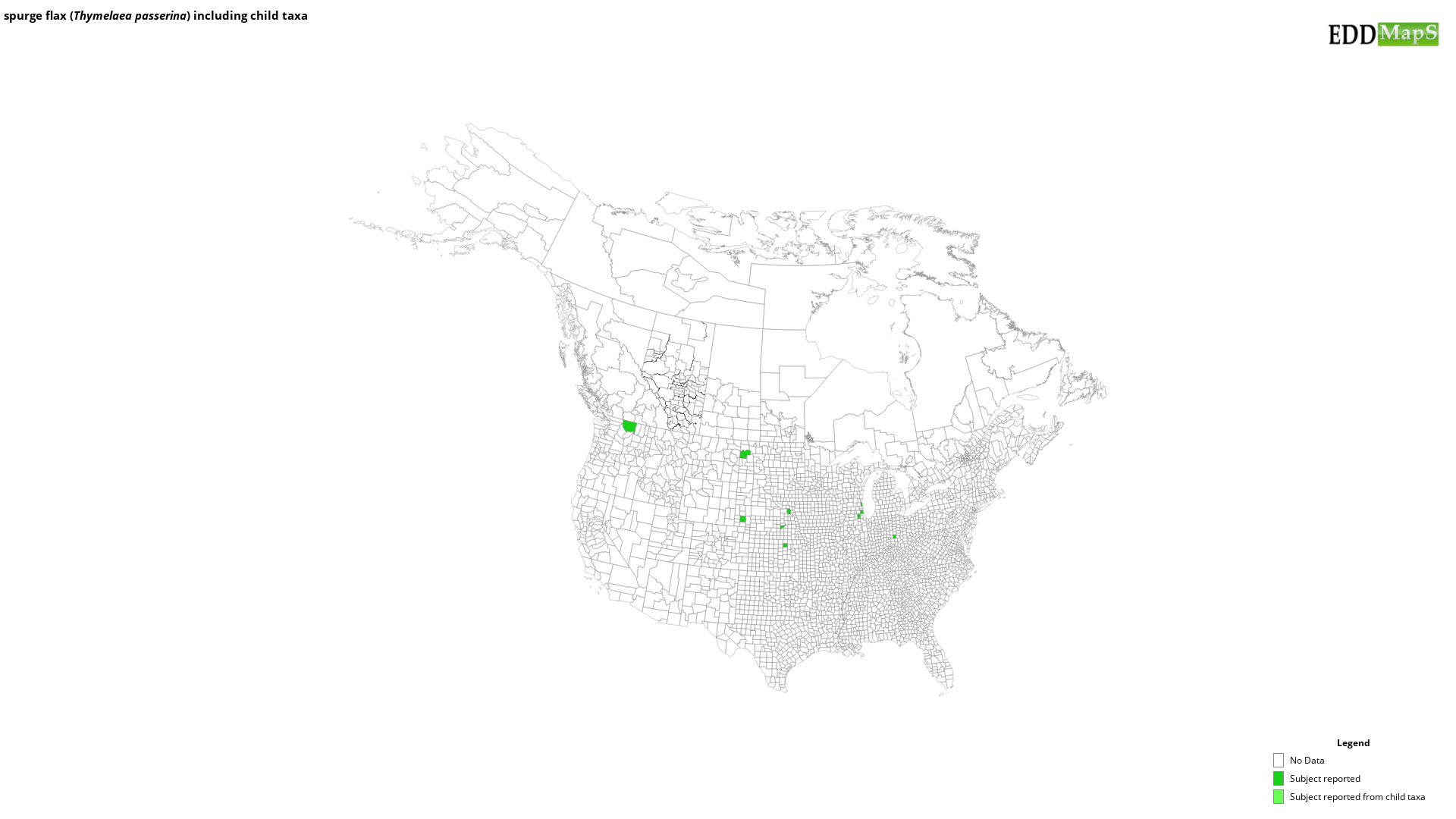spurge flax
(Thymelaea passerina)
This species is Introduced in the United States
ORIGIN: Eurasia, northern Africa
GROWTH TRAITS: Herbaceous annual growing 2½” to 2’ tall (6-60 cm) from a fibrous taproot. It may grow as a single stem, but more commonly the main stem splits into numerous branches in its upper reaches. Stems are slender and wiry. Leaves are alternate, leathery, and narrow with a tapered point. Leaves can be up to 1” long (2½ cm) but gradually become smaller up the stem. Flowers occur in leaf axils in summer. Each flower is yellowish-green, tubular, and small (2-3 mm long). Flowers have 4 sepals, no petals, and 8 stamens that appear in two whorls of 4. Each flower is subtended by 2 small bracts arising from a tuft of tiny white hairs. Fruits enclose single seeds that are 2-3 mm long, teardrop-shaped, and brown to black.
REPRODUCTION: By seed. It is unknown how long seeds remain viable in the soil.
HABITAT: Found in dry areas, including rangeland, pastures, abandoned fields, and roadsides.
LOOK-ALIKES: Several native and exotic species resemble spurge flax by having wiry stems, narrow leaves, and small flowers in leaf axils. Spurge flax can be differentiated by having 4 yellow-green sepals forming a tubular flower with 8 stamens. The look-alike Douglas’s knotweed (Polygonum douglasii) also has 8 stamens (though not in two whorls of 4). Douglas’s knotweed has star-shaped flowers with 5 whitish petals.
CITATIONS:
Winston, R.L., Andreas, J.E., Milan, J., DesCamp, W., Randell, C.B., and M. Schwarzländer. 2014. New Invaders of the Northwest. United States Department of Agriculture, Forest Health Technology Enterprise Team. FHTET-2014-12. Retrieved from https://www.fs.fed.us/foresthealth/technology/pdfs/FHTET-2014-12_NW_New_Invaders.pdf
GROWTH TRAITS: Herbaceous annual growing 2½” to 2’ tall (6-60 cm) from a fibrous taproot. It may grow as a single stem, but more commonly the main stem splits into numerous branches in its upper reaches. Stems are slender and wiry. Leaves are alternate, leathery, and narrow with a tapered point. Leaves can be up to 1” long (2½ cm) but gradually become smaller up the stem. Flowers occur in leaf axils in summer. Each flower is yellowish-green, tubular, and small (2-3 mm long). Flowers have 4 sepals, no petals, and 8 stamens that appear in two whorls of 4. Each flower is subtended by 2 small bracts arising from a tuft of tiny white hairs. Fruits enclose single seeds that are 2-3 mm long, teardrop-shaped, and brown to black.
REPRODUCTION: By seed. It is unknown how long seeds remain viable in the soil.
HABITAT: Found in dry areas, including rangeland, pastures, abandoned fields, and roadsides.
LOOK-ALIKES: Several native and exotic species resemble spurge flax by having wiry stems, narrow leaves, and small flowers in leaf axils. Spurge flax can be differentiated by having 4 yellow-green sepals forming a tubular flower with 8 stamens. The look-alike Douglas’s knotweed (Polygonum douglasii) also has 8 stamens (though not in two whorls of 4). Douglas’s knotweed has star-shaped flowers with 5 whitish petals.
CITATIONS:
Winston, R.L., Andreas, J.E., Milan, J., DesCamp, W., Randell, C.B., and M. Schwarzländer. 2014. New Invaders of the Northwest. United States Department of Agriculture, Forest Health Technology Enterprise Team. FHTET-2014-12. Retrieved from https://www.fs.fed.us/foresthealth/technology/pdfs/FHTET-2014-12_NW_New_Invaders.pdf
Maps
EDDMapS Distribution - This map is incomplete and is based only on current site and county level reports made by experts, herbaria, and literature. For more information, visit www.eddmaps.org
State Lists - This map identifies those states that have this species on their invasive species list or law.
Invasive Listing Sources
Taxonomic Rank
| Domain: Eukarya |
| Kingdom: Plantae |
| Phylum: Magnoliophyta |
| Class: Magnoliopsida |
| Superorder: Rosanae |
| Order: Malvales |
| Family: Thymelaeaceae |
| Genus: Thymelaea |
| Thymelaea passerina |
References
Common Name Reference: USDA, NRCS. 2010. The PLANTS Database. National Plant Data Center, Baton Rouge, LA, USA.
Scientific Name Reference: USDA, NRCS. 2010. The PLANTS Database. National Plant Data Center, Baton Rouge, LA, USA.


